Is this an 1850s copy of an 1840s photo?
|
|
Photos on glass did not exist until the early 1850s so if it the photo does depict the
Bronte sisters then it can only be a copy of an 1840s daguerreotype. Is there any evidence that
this is a copy?
|
|
Daguerreotype Photos
|
|
Daguerreotype studios opened throughout the United
Kingdom the 1840s. Success depended on the skill of the photographer to prepare and
process the photographic plate, the quality of the lens, the amount of daylight shining
into the studio [camera flash didn't exist] and the ability of the sitter to remain still for
several seconds.
Some of the earliest daguerreotypes were dark and disappointing but in
just a few years great improvements were made in chemicals and equipment; the
exposure time was reduced meaning that there was less chance of the sitter moving and becoming a
blur.
There are two examples of daguerreotype portraits taken
in 1848, of the Swedish soprano Jenny Lind (RCIN 2932511) & (RCIN 2932510), in the Royal Collection. For an example of an
outdoor daguerreotype depicting a large group, see the Group of Grooms &
pony Webster taken at Buckingham Palace, May 1848 (RCIN 29324991848).
|
|
Collodion
Photos
|
|
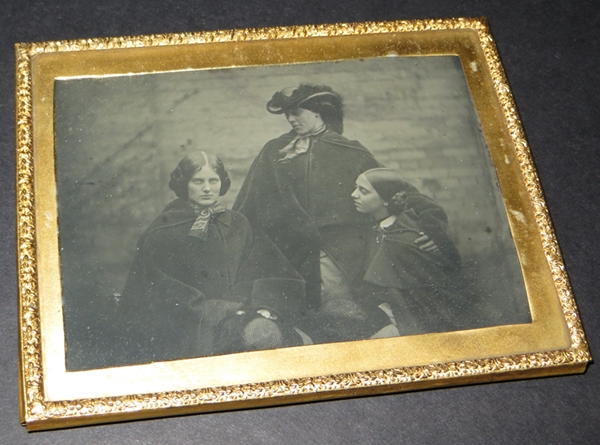
The photo with black backing paper.
|
|
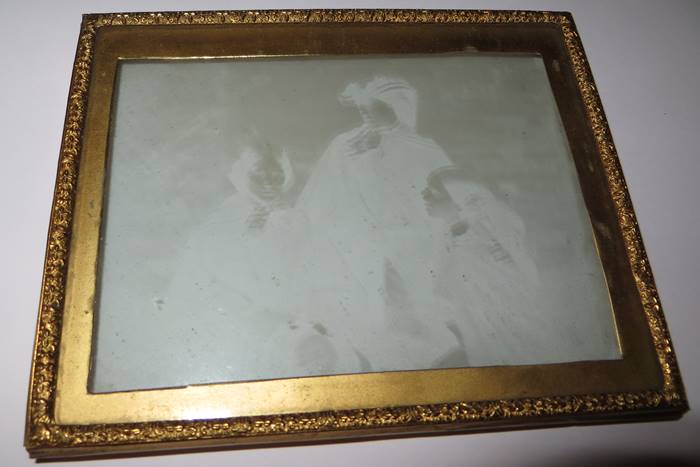
The photo with black backing paper removed.
|
Collodion photos were similar to later glass negatives but in the 1850s
they were new and most commercial portrait photographers were not yet using
them to make a print on paper. The finished product was the photo on glass and these were
presented in the same way as daguerreotypes had been since the early 1840s, in
a frame.
Dark paper or felt was placed behind the negative making the image appear
positive. To protect the photo a thin metal mat and cover glass was placed in front;
this was all held together by the frame. Because the collodion image-side normally faced
the person viewing it, the image was reversed and any lettering visible, such
as a shop sign, would appear to be back to front. 1.
|
|
Orientation
|
|
If the photo is
simply an 1850s picture of three ladies
then the orientation is as
below.
|
|
1850s
AS THE PHOTOGRAPHER WOULD
HAVE VIEWED THE GROUP
(orientation is correct)
"Charlotte" on the
right.
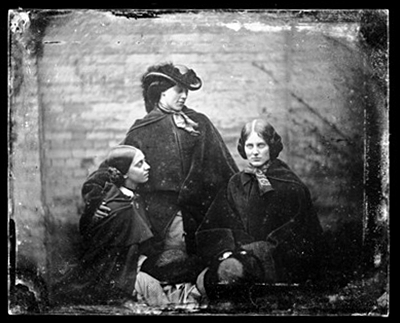
|
1850s
COLLODION PHOTO
(a glass negative)
(the image is reversed)
"Charlotte" on
the left.
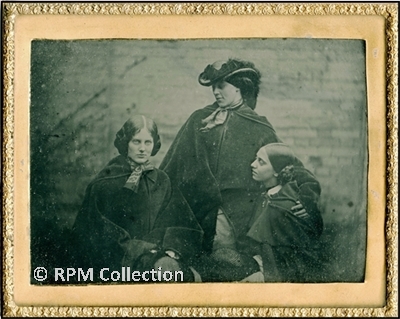
This applies when the side with the collodion image faces the person viewing
it.
|
|
The collodion photo was in effect a glass negative. If
a paper print were made it would appear just as the
photographer viewed the group.
|
|
If the photo is a collodion copy of a
daguerreotype then the orientation is as
below.
|
|
1840s
AS THE PHOTOGRAPHER WOULD
HAVE VIEWED THE GROUP
(orientation is correct)
Charlotte on the
left.
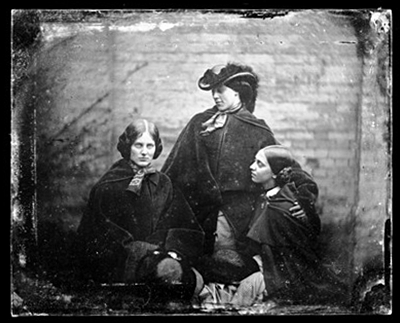
|
1840s
DAGUERREOTYPE PHOTO
(the image is reversed)
Charlotte on
the right.

|
1850s
COLLODION COPY OF A DAGUERREOTYPE?
(a glass negative)
(orientation
is correct)
Charlotte on
the left.

This applies when the side with the collodion image faces the person viewing
it.
|
|
A collodion photo is in effect a glass negative; if from
this a paper print is correctly made, it would appear reversed,
the same as the daguerreotype photo, with Charlotte on the right.
|
|
In both the 'Richmond Portrait' and the
'Pillar Portrait' Charlotte's hair is parted on her left and her
mouth turns down slightly on her right. This is the same in the collodion
photo.
|
|
|
|
Copying Daguerreotypes
in the 1840s & 1850s
|
|
Daguerreotypes were one-off photographs on a silvered copper plate with no
negative to make copies. In the early days the only way of having a copy was to photograph the
original. This was a service offered by many photographers, even in the 1840s; for an example of a
daguerreotype copy click here (external website). Copies became more common from
the early 1850s when collodions (photos on glass) were introduced because they were
cheaper to produce.
Copying daguerreotypes which had a mirror-like reflective surface wasn't easy
but was possible. One method was to photograph the daguerreotype at an angle; a later method used a
black-lined box with the daguerreotype at one end, camera at the other, with light entering at
the sides. 2.
For an early example see Mathew Brady's daguerreotype copy made from his daguerreotype of the artist Thomas Cole c1846. For
an example of a daguerreotype copied at an angle see this copy daguerreotype of a lady; the first image appears to be a photograph of
a lady but the second image, showing the photo removed from
its case, reveals it to be a copy of a daguerreotype.
The methods used to copy daguerreotypes in the 1850s were exactly the same as
those used a century later. They were successfully copied and evidence of this is that
many were reproduced as carte de visite photos in the 1860s, and in books from the 1880s
onwards.
|
|
Example of a
Daguerreotype & an 1850s Collodion Copy.
|
|
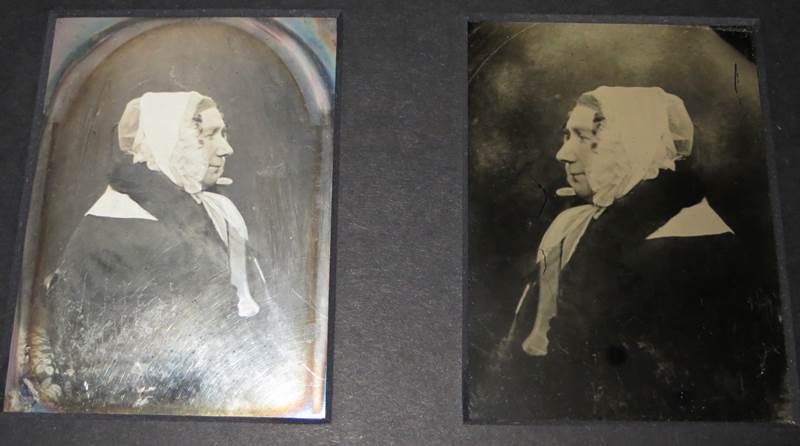
An 1840s daguerreotype (left) and an 1850s
collodion copy (right). The marks around the edges of the original daguerreotype were made by a
metal frame which has reacted with the silver surface of the photo. When the photographer copied it
he photographed the centre, so as to avoid the edges though the curve can be partly seen at
the top. Photographs from the 1840s-50s era are usually reversed images. In copying the photo it
reversed the image again, making the orientation correct.
The image on the right is an example of a collodion photograph on glass. If it
were taken to an expert they would probably date it to the 1850s-60s because
the earliest photos on glass date from the early 1850s. Occasionally though, the
images are earlier because some are copies of daguerreotypes from the 1840s.
It is difficult to know whether a photo is a copy unless the original exists
but sometimes there are clues. Within the 'Bronte Sisters Photo' there are several clues
which suggest that it could be a copy of a daguerreotype.
|
|
Comparing the 'Bronte Sisters Photo' with other
collodion photos from the 1850s-60s.
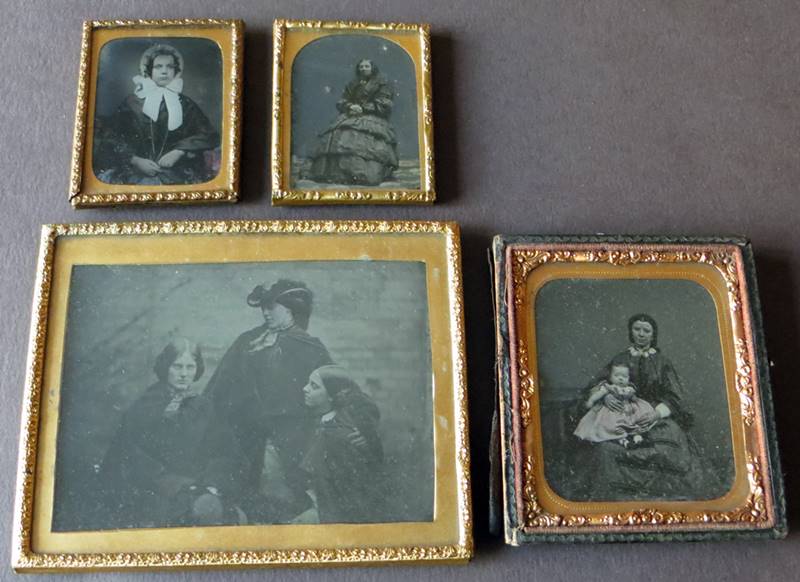
When the 'Bronte Sisters Photo' is compared with
other collodions it is larger than most, there is an
overall greyish cast and a lack of
contrast. The photograph is not level. The hand-cut metal mat
is unusual; one edge is straight, the opposite edge is slightly concave, and
the other two are uneven, as with the photo of the Parsonage (c1857) at the Bronte Parsonage Museum
(see Bronte Connection).
|
|
|
Clues that suggest the Photo
is a Copy
|
|
1. The Greyish Cast
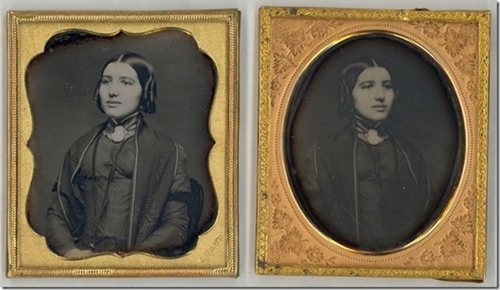
This is an example of a Daguerreotype (left) and a copy (right). As with
the 'Bronte Sisters Photo' there is a greyish cast and a lack of contrast. This is
common in copied photographs.
In later years, when photos were printed on paper from a negative, the contrast
could be increased to improve the image.
|
|
2. The photo is not level.
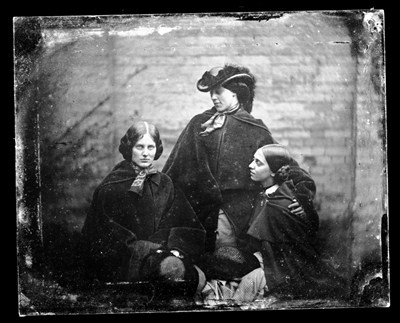 When taking a photo in the 1850s one of the first things the photographer did
was to ensure that the camera was level. The glass plate in the camera would become the final
photo and it couldn't be altered afterwards. When taking a photo in the 1850s one of the first things the photographer did
was to ensure that the camera was level. The glass plate in the camera would become the final
photo and it couldn't be altered afterwards.
If this is simply a photo of three women then it should have been easy
for the photographer as there's a brick wall in the background but the photo is on a slant.
If this is copy of a photograph then the slant may be due to the
fact that it is not easy to keep the camera level, especially if the surface of the
photo is reflective. With the mirrored surface of a daguerreotype it necessitates moving
and tilting the camera to find the best angle.
The photo is shown here with contrast increased and tilted to the correct level
on a horizontal black background.
|
|

3. Circular black mark
Along the base of the image is a distinct black ring and this doesn't
appear to be damage to the photo. If this is simply a photograph of the ladies it shouldn't be
there. If it were a copy of a photo then it could be a mark on the original left by the mat and
frame which would have been removed to copy it.
|
|
4. Distortions
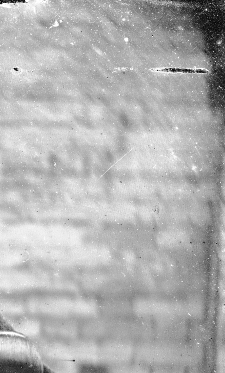
To the top right-hand corner there are distortions which are consistent with
photographing a reflective surface. Along the top right-hand side there are swirls which can
happen when photographing a reflective surface at an angle.
|
|
5. Orientation
If it is a collodion copy of a daguerreotype then the
orientation should be correct and it is correct for Charlotte's hair, parted on her
left, and the slight asymmetry of her mouth.
If a print were correctly made from this negative then it would be reversed,
like the daguerreotype, with Charlotte on the right. A paper print may have been made for the
publisher, George Smith, in London. In 1863 he commissioned Frederick Walker
to illustrate any scene from Jane Eyre and he chose the garden scene with a
brick wall in the background and characters appear to be based on the ladies in the photo. See
the Frederick Walker page.
|
|
6. Detail
The 'Bronte Sisters Photo' contains a fair amount of detail but less
perhaps than might be expected given the size of the glass plate. When photos were copied
some detail was always lost.
|
|
7. Blemishes
Most of the images taken from the photo and displayed on this website have been
edited to remove various blemishes, some black and some white. If at some stage in the future the
photo is analysed then it should be possible to determine whether all these various marks are
simply dust, dirt or damage on the glass plate. If this is a copy then some marks may be dust,
dirt or damage on the original photo.
|
|
|
|
|
1. There were variations where photographers used
coloured varnish. See Early Photography - Collodion Positives on Glass (Ambrotype).
2. There is an example of a collodion copy of a
daguerreotype on the Royal Collection website; it has been photographed at an angle although
another method using a box also existed. The copy survives but the original daguerreotype been
lost, possibly because the case was not resealed correctly after being copied, causing
tarnishing/damage. If the 'Bronte Sisters Photo' is a copy then the photographer has only
photographed the centre of the daguerreotype, not the whole plate.
|

